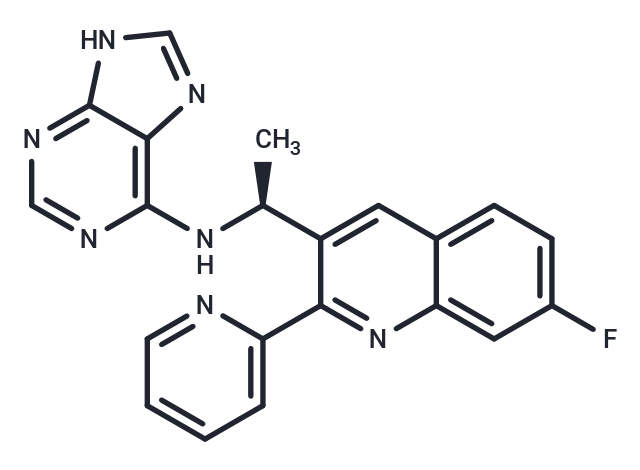Shopping Cart
- Remove All
 Your shopping cart is currently empty
Your shopping cart is currently empty

AMG319 is a potent and selective PI3Kδ inhibitor with an IC50 of 18 nM and exhibits >47-fold selectivity over other PI3Ks. [Phase 2]

| Pack Size | Price | Availability | Quantity |
|---|---|---|---|
| 2 mg | $42 | In Stock | |
| 5 mg | $68 | In Stock | |
| 10 mg | $113 | In Stock | |
| 25 mg | $239 | In Stock | |
| 50 mg | $409 | In Stock | |
| 100 mg | $596 | In Stock | |
| 1 mL x 10 mM (in DMSO) | $74 | In Stock |
| Description | AMG319 is a potent and selective PI3Kδ inhibitor with an IC50 of 18 nM and exhibits >47-fold selectivity over other PI3Ks. [Phase 2] |
| Targets&IC50 | PI3Kδ:18 nM |
| In vitro | AMG319 inhibits anti-IgM/CD40L-induced B cell proliferation with IC50 of 8.6 nM and reduces pAkt level with IC50 of 1.5 nM. AMG319 also inhibits anti-IgD-induce CD-69 expression in HWB. [1] |
| In vivo | In female Lewis rats, AMG319 (3 mg/kg, p.o.) inhibits the KLH-induced inflammatory response by 88%. In the transgenic (IgMm) mice, AMG319 (, p.o.) inhibits in vivo pAKT with IC50 of 1.9 nM. [1] |
| Kinase Assay | PI3K Enzyme Assays: A PI3K Alphascreen assay is used to measure the activity of a panel of four phosphoinositide 3-kinases: PI3Kα, PI3Kβ, PI3Kγ, and PI3Kδ. Enzyme reaction buffer is prepared using sterile water and 50 mM Tris-HCl, pH 7, 14 mM MgCl2, 2 mM sodium cholate, and 100 mM NaCl. 2 mM DTT is added fresh on the day of the experiment. The Alphascreen buffer is made using sterile water and 10 mM Tris-HCl, pH 7.5, 150 mM NaCl, 0.10% Tween 20, and 30 mM EDTA. Then 1 mM DTT is added fresh on the day of the experiment. Compound source plates used for this assay are 384-well Greiner clear polypropylene plates containing test compounds at 5 mM and diluted 1:2 over 22 concentrations. Columns 23 and 24 contained only DMSO, as these wells comprised the positive and negative controls, respectively. Source plates are replicated by transferring 0.5 μL per well into 384-well Optiplates. Each PI3K isoform is diluted in enzyme reaction buffer to 2× working stocks. PI3Kα is diluted to 1.6 nM, PI3Kβ is diluted to 0.8 nM, PI3Kγ is diluted to 15 nM, and PI3Kδ is diluted to 1.6 nM. PI(4,5)P2 is diluted to 10 μM, and ATP was diluted to 20 μM. This 2× stock is used in the assays for PI3Kα and PI3Kβ. For assay of PI3Kγ and PI3Kδ, PI(4,5)P2 is diluted to 10 μM and ATP was diluted to 8 μM to prepare a similar 2× working stock. Alphascreen reaction solutions are made using beads from the anti-GST Alphascreen kit. Two 4× working stocks of the Alphascreen reagents are made in Alphascreen reaction buffer. In one stock, biotinylated-IP4 is diluted to 40 nM and streptavadin-donor beads are diluted to 80 μg/mL. In the second stock, PIP3-binding protein is diluted to 40 nM and anti-GST-acceptor beads were diluted to 80 μg/mL. As a negative control, a reference inhibitor at a concentration ?Ki (40 μM) is included in column 24 as a negative (100% inhibition) control. Using a 384-well Multidrop, 10 μL/well of 2× enzyme stock is added to columns 1–24 of the assay plates for each isoform.An amount of 10 μL/well of the appropriate substrate 2× stock (containing 20 μM ATP for the PI3Kα and -β assays and containing 8 μM ATP for the PI3Kγ and -δ assays) is then added to columns 1–24 of all plates. Plates are then incubated at room temperature for 20 min. In the dark, 10 μL/well of the donor bead solution is added to columns 1–24 of the plates to quench the enzyme reaction. The plates are incubated at room temperature for 30 min. Still in the dark, 10 μL/well of the acceptor bead solution is added to columns 1–24 of the plates. The plates are then incubated in the dark for 1.5 h. The plates are read on an Envision multimode plate reader using a 680 nm excitation filter and a 520–620 nm emission filter. |
| Molecular Weight | 385.4 |
| Formula | C21H16FN7 |
| Cas No. | 1608125-21-8 |
| Smiles | C[C@H](Nc1ncnc2[nH]cnc12)c1cc2ccc(F)cc2nc1-c1ccccn1 |
| Relative Density. | 1.432 g/cm3 (Predicted) |
| Storage | Powder: -20°C for 3 years | In solvent: -80°C for 1 year | Shipping with blue ice. | |||||||||||||||||||||||||||||||||||
| Solubility Information | DMSO: 71 mg/mL (184.22 mM), Sonication is recommended. Ethanol: 71 mg/mL (184.22 mM), Sonication is recommended. H2O: < 1 mg/mL (insoluble or slightly soluble) | |||||||||||||||||||||||||||||||||||
Solution Preparation Table | ||||||||||||||||||||||||||||||||||||
DMSO/Ethanol
| ||||||||||||||||||||||||||||||||||||

Copyright © 2015-2025 TargetMol Chemicals Inc. All Rights Reserved.